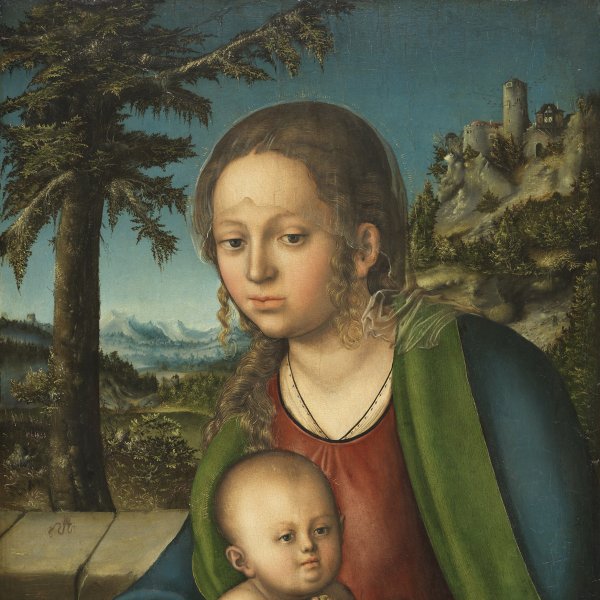Portrait of a Woman
1510
Oil on panel.
37.5 x 28.5 cm
Museo Nacional Thyssen-Bornemisza, Madrid
Inv. no.
408
(1928.23
)
Not on display
Level 2
Permanent Collection
Level 1
Permanent Collection
Level 0
Carmen Thyssen Collection and Temporary exhibition rooms
Level -1
Temporary exhibition rooms, Conference room and EducaThyssen workshop
According to Johann Neudörfer, Wolf Traut was the son of the painter Hans Traut, with whom he may have initially trained. Around 1505 he was in Dürer’s studio in Nuremberg, which was a crucial experience for his professional formation. Throughout his career Traut primarily devoted himself to painting altarpieces and to executing designs for prints in which the influence of Dürer is evident. In the decade in which the present panel was painted Traut received various important commissions including the paintings for the high altar of the Johanneskirche in Nuremberg around 1511; the paintings for the abbey at Heilsbronn in 1513; and his masterpiece, The Holy Kinship of 1514, painted for the Tuchmacherkapelle in the church of St. Lorenz in Nuremberg, donated by Cunz Horn (now in the Nationalmuseum, Nuremberg). Between 1512 and 1515 Traut worked in Dürer’s studio on the decoration for the Great Arch of Maximilian.
The present portrait was formerly in the collection of the Count of Pappenheim and was acquired in 1928 from the Hackenbroch gallery. The painting was first shown to the public in the exhibition of works from the Collection held at the Neue Pinakothek in Munich in which it appeared with its present attribution but with the sitter identified as Katharina Geyger, as she is again described in the 1937 catalogue of the Collection. The panel was studied by Hugelshofer in the 1930s and by Ernst Buchner, who attributed it in his report to Wolf Traut.
On the reverse of the panel is a coat-of-arms with the date of 1564 and an inscription that states that the sitter is Katharina Geyger aged 35. The problem of the sitter’s identity and the coat-of-arms was discussed by Buchner in his report, as the centre of the shield, which is surrounded by scrolls, cartouches and other decorative motifs, has a hunting horn which is not the emblem of the Geyger family of Nuremberg, whose emblem was a violin and a mortar. The date of 1564 does not correspond to the date of the painting’s execution, which appears in gold at the top right and Buchner suggested that the inscription on the reverse might have formed part of the original frame. The interpretation of the letter “g” on the front is more complex but it may be the first letter of the sitter’s surname, while the owl on a branch, the traditional symbol of Minerva, might in this context symbolise wisdom, sleep, death or night.
For the composition of this portrait Traut followed a model developed by Dürer. The woman, depicted bust-length, is set against a green background onto which her shadow is projected. She wears fashionable dress, while the large chain around her neck and the group of rings on her index finger indicate her elevated social status. Traut defined her body through large areas of colour but without strong modelling. His principal area of interest was, however, the face, which is realistically painted and constructed in detail, unlike the neck and bust. Few portraits by Traut are known and the style and date of the present example make it a fundamental work within his oeuvre.
Mar Borobia
The present portrait was formerly in the collection of the Count of Pappenheim and was acquired in 1928 from the Hackenbroch gallery. The painting was first shown to the public in the exhibition of works from the Collection held at the Neue Pinakothek in Munich in which it appeared with its present attribution but with the sitter identified as Katharina Geyger, as she is again described in the 1937 catalogue of the Collection. The panel was studied by Hugelshofer in the 1930s and by Ernst Buchner, who attributed it in his report to Wolf Traut.
On the reverse of the panel is a coat-of-arms with the date of 1564 and an inscription that states that the sitter is Katharina Geyger aged 35. The problem of the sitter’s identity and the coat-of-arms was discussed by Buchner in his report, as the centre of the shield, which is surrounded by scrolls, cartouches and other decorative motifs, has a hunting horn which is not the emblem of the Geyger family of Nuremberg, whose emblem was a violin and a mortar. The date of 1564 does not correspond to the date of the painting’s execution, which appears in gold at the top right and Buchner suggested that the inscription on the reverse might have formed part of the original frame. The interpretation of the letter “g” on the front is more complex but it may be the first letter of the sitter’s surname, while the owl on a branch, the traditional symbol of Minerva, might in this context symbolise wisdom, sleep, death or night.
For the composition of this portrait Traut followed a model developed by Dürer. The woman, depicted bust-length, is set against a green background onto which her shadow is projected. She wears fashionable dress, while the large chain around her neck and the group of rings on her index finger indicate her elevated social status. Traut defined her body through large areas of colour but without strong modelling. His principal area of interest was, however, the face, which is realistically painted and constructed in detail, unlike the neck and bust. Few portraits by Traut are known and the style and date of the present example make it a fundamental work within his oeuvre.
Mar Borobia








